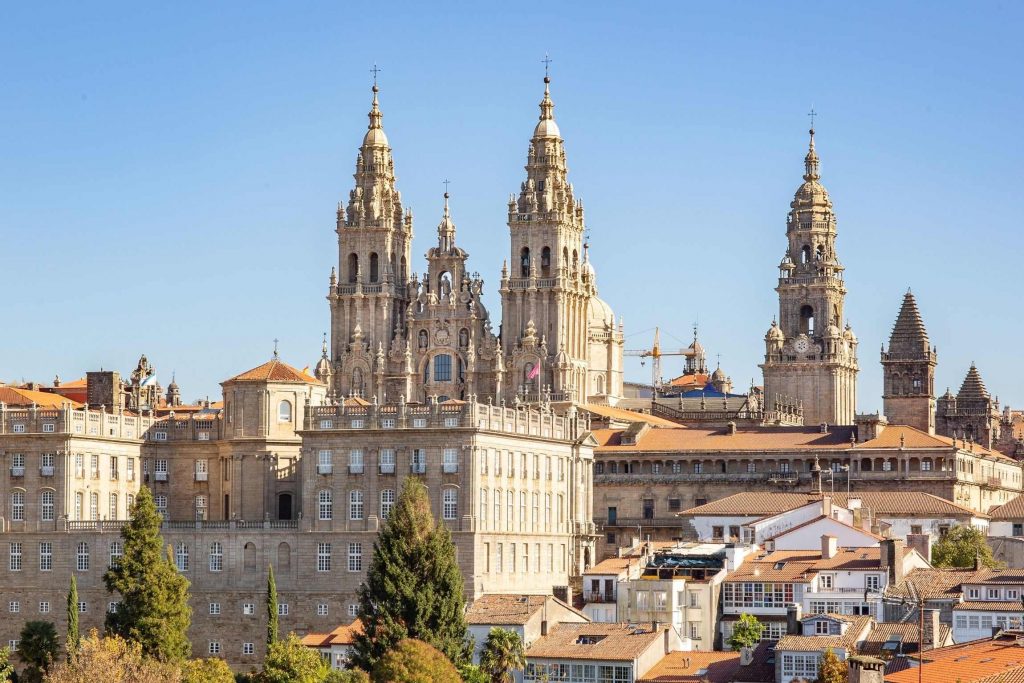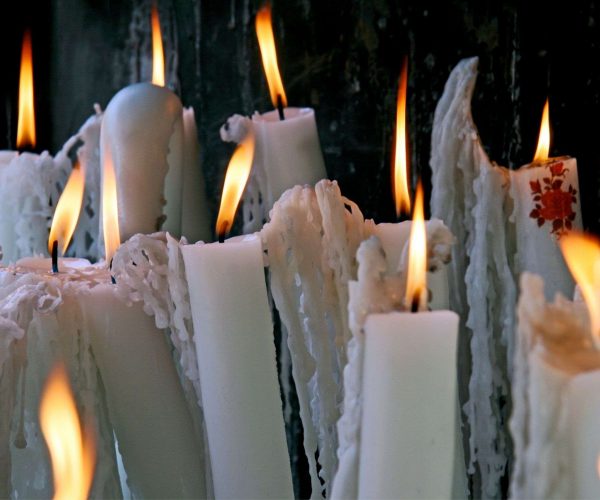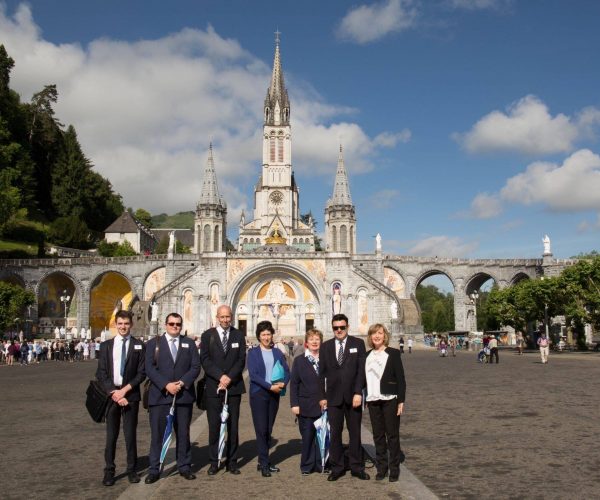As Camino pilgrims reach Monte do Gozo, the Mount of Joy, they can catch a first glimpse of their destination: the magnificent Santiago de Compostela Cathedral. This place marks the last stretch of their pilgrimage with the city of Saint James finally within reach, hence the joy that gives this hill its name.
Pilgrims from all over Europe and beyond, have been travelling to Santiago de Compostela Cathedral for many centuries to pay their respects to the relics of Saint James the Apostle, since his remains were discovered in the 9th century.

DISCOVERY OF SAINT JAMES
A shepherd by the name of Pelayo made this great discovery, having followed some stars to a nearby field; hence the name of Santiago De Compostela which means Saint James of the Field of Stars.
King Alfonso II made his way from Oviedo to Santiago De Compostela on the route known today as the Camino Primitivo to confirm the authenticity of the discovery and give the relics his royal seal of approval, becoming the first official pilgrim on the Camino de Santiago.
A small stone chapel was built in 813 to host the relics but as word spread the shrine became too small to welcome all pilgrims and visitors who wanted to honour Saint James. Construction of a bigger sanctuary under the auspices of the King started in 872 but this church would be later destroyed by Islamic leader Almazor as he raided the city in the year 997. The church bells were taken to the Mosque in Cordoba and wouldn’t return to Santiago De Compostela Cathedral until 200 years later.
Bishop San Pedro de Mezonzo would rebuild the temple in 1003. It would be rebuilt again in1075 as the King of León Alfonso VI and the city’s archbishop Diego Gelmírez promoted the building of a Cathedral that would accommodate all pilgrims, which is the origin of today’s magnificent building.
The 12th century marked the most important period of pilgrimage to Santiago de Compostela and it would become one of the holiest pilgrimage sites of the Christian world, with the Holy Land and Rome. The Codex Calixtinus, named after Pope Callixtus II, was written at this time by French scholar Aymeric Picaud, as a practical guide to pilgrims on the Camino de Santiago.
THE CATHEDRAL
When it was built, Santiago de Compostela Cathedral was Europe’s tallest building at 76 metres and one of the most spectacular shrines in the Christian world at that time. Many elements would be added to the original building over the centuries but Santiago de Compostela Cathedral remains a stunning Romanesque Cathedral in essence.
In 1181, Pope Alexander III granted the privilege of plenary absolution to all those visiting the Cathedral during a Holy Year, which takes place when Saint James Day, 25th July, falls on a Sunday. A document was also issued to pilgrims who had completed the Camino de Santiago, and this document still lasts to this day: the Compostela pilgrim certificate. The Basilica was consecrated in 1211 before Alfonso IX.
The extraordinary Portico da Gloria, the Glory Gate, also dates from this time. It took Mestre Mateo nearly 20 years to complete this masterpiece featuring over 200 sculptures inspired by different figures and chapters from the Bible.
As you enter the Cathedral, you can see the figure of Saint James the Apostle welcoming pilgrims after their journey. Following extensive restoration works, the full beauty of the Pórtico da Gloria can be admired again by pilgrims, including the mysterious ‘Santo dos Croques’, which is in fact a ‘self sculpture’ of Mestre Mateo. Visits are free but tickets are required from the Museo Catedral de Santiago.
Over time, Gothic, Renaissance and Baroque elements were integrated into the original temple, giving Santiago Cathedral its unique character: new chapels, towers such as the 14th century Clock Tower and Renaissance cloister for instance were all added.
The most iconic addition to the original building is the glorious Baroque facade we see today as we enter the Praza do Obradoiro, which dates from the 17th century.

PILGRIM TRADITIONS
There are many traditions for pilgrims visiting Santiago De Compostela Cathedral and here are some of the most important ones:
VISIT THE CRYPT
Under the Main Altar, pilgrims visit the crypt where the sepulchre of Saint James is kept to say a prayer and pay their respects.
HUGGING SAINT JAMES
Over the crypt, a set of stairs take up to the figure of Saint James that presides over the Main Altar where pilgrims have the tradition of embracing the Apostle and saying the following words.
“Thank you friend Saint James, brother Saint James, for helping me get here. Thank you for your person, your company, your testimony and your legacy.”
¡Gracias amigo Santiago, hermano Santiago, por ayudarme a llegar hasta aquí! ¡Gracias por tu persona, por tu compañía, por tu testimonio, por tu legado!
PIGRIM PASS
Pilgrim Mass takes place daily at the Cathedral and can be an emotional event for pilgrims who have walked for many days, weeks and even months to reach Santiago de Compostela. In addition to the pilgrim mass, there are many other mass services evert day, including confession and mass in different languages.
PORTA SANTA
The Holy Door or Porta Santa was built in the 16th century on the Praza da Quintana entrance. It only opens during Holy Years, Ano Xacobeo and is also known as the Forgiveness Door, Porta do Perdon.
This back door takes pilgrims straight to the back of the Main Altar with easy access to the crypt where the tomb of Saint James is located.
The Holy Door is generally opened on the 31st December ahead of each Holy Year.
BOTAFUMEIRO
The Botafumeiro is an impressive incense thurible which swings across the Main Altar on special dates and sometimes during pilgrim mass.
It weights 53 kilograms, measures one and half metres and takes eight men, known as ‘tiraboleiros’, to swing it. It is quite a remarkable experience to see it swing across the Cathedral at a speed of 68kms per hour.
While the origins of the Botafumeiro are unclear, it is believed it was used to cover up the smell of the crowds as they gathered for mass after their long journey. There have been many different censers and one currently in use dates back to the 19th century.
THE JOURNEY OF LIFE
Looking at the Platerías entrance, pilgrims look at the facade . Between the two gates there is a symbol of Christ but the letters are inverted: Alfa is Omega and Omega has become Alfa. This means the end becomes the beginning. The goal of the Camino is now the beginning of another Camino, another path: the new life that the pilgrim is about to start.
SANTIAGO DE COMPOSTELA CATHEDRAL TOURS
Santiago de Compostela Cathedral is open to pilgrims and visitors every single day of the year.
Guided tours of Santiago de Compostela Cathedral can be booked at the Cathedral Museum, where pilgrims can learn more about the fascinating history, art, architecture and secrets of this stunning building. The rooftop tour gives visitors a wonderful perspective of the Cathedral and the city; and it is highly recommended (only if you are not scared of heights!).
You can find additional details and information about mass and tours at the Cathedral website: www.catedraldesantiago.com
For more information about our upcoming Camino de Santiago tours or to organise a group trip contact the Joe Walsh Tours Pilgrimage travel experts.
Contact Us



